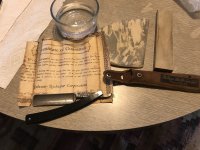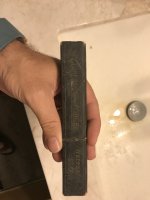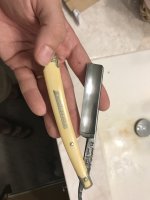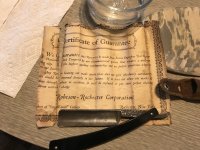As a wet shaving Noob myself, I have been following this thread with a keen eye. As an old-time machinist, I have vast honing experience, albeit of the cylindrical variety on a Sunnen Hone. I use a wide variety of stones, mostly AO, but also CBN and Diamond. There also a large variety of bonds available.
The main difference between honing a round bore versus a flat edge is just that. They are both measured for straightness. flatness, and surface finish along the longitude of the surface. The stones are the same, the stroke is determined by the operator as is the flow of lubricant.
What is different is the way that pressure is applied. With a cylinder hone the pressure is applied by mechanical force, but the feel is transferred through the hands of the operator. With a razor the amount of force used it kept to a minimum.
Sunnen offers stones made of cork with very fine grit, which is comparable to pasted balsa.
Sunnen also has a tag on the machines that state "always use the lightest pressure that gives the greatest cutting action".
I believe this experience will help me as I try to learn to wax on, wax off with a variety of stones, films, and paste.
I also believe half the answer to the OP's post is metallurgical. I believe it is the way the Japanese treat their steels.
Much of this thread centers on the stones, but to hold and edge you must first start with quality steels and proper tempering. When the Japanese quench the steel in cold water the micro-grain structure changes, and this alone allows the steel to hold its edge. This is documented and measure-able.
I have honed materials to a mirror finish with cork and AO, you don't need diamonds or CBN, you need experience.
And when it comes to honing razors, experience is something I don't have. I don't even know if I am setting the bevel correctly. Lol
BTW, @Chan Eil Whiskers, If you could find your way to PM me where I might find a Japanese razor like the ones you have pictured I will be forever in your debt.
prof
The main difference between honing a round bore versus a flat edge is just that. They are both measured for straightness. flatness, and surface finish along the longitude of the surface. The stones are the same, the stroke is determined by the operator as is the flow of lubricant.
What is different is the way that pressure is applied. With a cylinder hone the pressure is applied by mechanical force, but the feel is transferred through the hands of the operator. With a razor the amount of force used it kept to a minimum.
Sunnen offers stones made of cork with very fine grit, which is comparable to pasted balsa.
Sunnen also has a tag on the machines that state "always use the lightest pressure that gives the greatest cutting action".
I believe this experience will help me as I try to learn to wax on, wax off with a variety of stones, films, and paste.
I also believe half the answer to the OP's post is metallurgical. I believe it is the way the Japanese treat their steels.
I do not believe any straight razor I've honed or used measures up to the Japanese razor used yesterday, in sharpness and in the shave it gave me.
I also don't want to have to resort to diamonds and CBN unless I just have to, nor do I plan to go down the jnat rabbit hole unless I just have to. Do I have to do either or both?
Much of this thread centers on the stones, but to hold and edge you must first start with quality steels and proper tempering. When the Japanese quench the steel in cold water the micro-grain structure changes, and this alone allows the steel to hold its edge. This is documented and measure-able.
I have honed materials to a mirror finish with cork and AO, you don't need diamonds or CBN, you need experience.
And when it comes to honing razors, experience is something I don't have. I don't even know if I am setting the bevel correctly. Lol
BTW, @Chan Eil Whiskers, If you could find your way to PM me where I might find a Japanese razor like the ones you have pictured I will be forever in your debt.
prof







